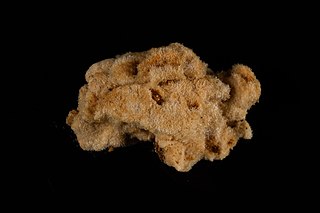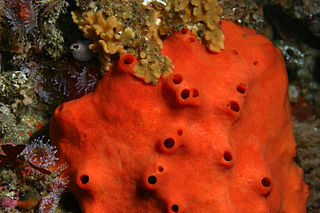
Spicules are structural elements found in most sponges. Sponge spicules are made of calcium carbonate or silica. Large spicules visible to the naked eye are referred to as megascleres, while smaller, microscopic ones are termed microscleres. The meshing of many spicules serves as the sponge’s skeleton and thus it provides structural support and potentially defense against predators. The composition, size, and shape of spicules are major characters in sponge systematics and taxonomy.

Agelas is a genus of sea sponge in the class Demospongiae.
Agelas flabelliformis, also known as the elephant ear sponge, is a species of demosponge. It takes the form of a large leathery slender flap and is found in the Caribbean area at depths down to 100 metres (330 ft).

Potamolepidae is a family of freshwater sponges, with seven genera:
The Heteractinids are a grade of sponges that are paraphyletic with respect to Hexactinellida. Their distinctive trait is their six-pronged (snowflake-like) spicules, whose symmetry historically suggested a relationship with the triradial Calcarean sponges. Nevertheless, they actually represent a polyphyletic grade, from which the hexactinellids arose.

Gelliodes is a genus of sponges in the family Niphatidae.
Gelliodes fibrosa is a species of sponge found in shallow water in the Indian Ocean. It was first described in 1905 by the British zoologist Arthur Dendy, the type locality being the Gulf of Mannar, Sri Lanka. In 1925, the American zoologist Edmund Beecher Wilson described a species of sponge from North Sulawesi as Gelliodes fibrosa. In 2013, Carballo, Aquilar-Camacho, Knapp & Bell, decided that this was a homonym, a separate taxon from the original one described by Dendy, and gave the new species the name Gelliodes wilsoni.
Gelliodes wilsoni, sometimes known as the gray encrusting sponge, is a species of sponge found in shallow water in the Philippines. It was first described in 1925 by the American zoologist Edmund Beecher Wilson, the type locality being North Sulawesi. He gave it the name Gelliodes fibrosa, a name already used in 1905 for a species in the Gulf of Mannar, Sri Lanka. In 2013, Carballo, Aquilar-Camacho, Knapp & Bell, decided that this was a homonym, a separate taxon from the original one given that name, and gave the new species the name Gelliodes wilsoni.

Tedania is a genus of sea sponges in the family Tedaniidae.

Staurocalyptus is a genus of sponge. It was circumscribed in 1897 by Isao Ijima.
Agelas dispar is a species of demosponge in the family Agelasidae. It lives on shallow-water reefs in the Caribbean Sea and around the West Indies.
Biemna variantia is a species of sponge in the family Biemnidae. It is native to the northwestern Atlantic Ocean, the northeastern Atlantic Ocean, the North Sea and the Mediterranean Sea. This species was first described in 1858 by the British naturalist James Scott Bowerbank, who gave it the name Halichondria variantia. It was later moved to the genus Biemna and is the type species of the genus. The type locality is Tenby, Wales.

Leuclathrina is a genus of sponges belonging to the family Leucaltidae. Species are found in the northeast Atlantic and in the Indian Ocean.

Leucettusa is a genus of sponges belonging to the family Leucaltidae. The species of this genus are mostly known from the Arctic and Antarctic, New Zealand and Southwest Australia.
Acanthochaetetidae is a family of sponges belonging to the order Clionaida. It is largely extinct, but contains two extant genera, each of which are represented by single extant species.

Acarnidae is a family of sponges belonging to the order Poecilosclerida. It has a global distribution, although several genera occur primarily in colder temperate waters, and several have very restricted ranges. It is estimated that there are several hundred species.

Iophon is a genus of sponges belonging to the family Acarnidae. The genus has a cosmopolitan distribution.

Coelosphaeridae is a family of sponges belonging to the order Poecilosclerida. Species are found across the globe.

Acarnus is a genus of sponges belonging to the family Acarnidae.The genus has almost cosmopolitan distribution.

Phorbas is a genus of demosponges belonging to the family Hymedesmiidae.












